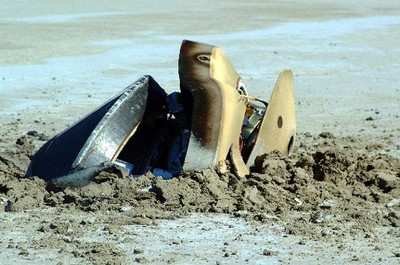Sun, Sep 19, 2004
But It's Looking Good...
Genesis team scientists and engineers continue their work on the
mission's sample return canister in a specially constructed clean
room at the US Army Proving Ground in Dugway (UT). As more of the
capsule's contents are revealed, the team's level of enthusiasm for
the amount of science obtainable continues to rise.

Right now, the science canister that holds the majority of the
mission's scientific samples is lying upside down - on its lid.
Scientists are very methodically working their way "up" from the
bottom portion of the canister by trimming away small portions of
the canister's wall. The team continues to extract, from the
interior of the science canister, small but potentially analyzable
fragments of collector array material. One-half of a sapphire wafer
was collected Tuesday - the biggest piece of collector array to
date.
The mission's main priority is to measure oxygen isotopes to
determine which of several theories is correct regarding the role
of oxygen in the formation of the solar system. Scientists hope to
determine this with isotopes collected in the four target segments
of the solar wind concentrator carried by the Genesis spacecraft.
The condition of these segments will be better known over the next
few days, after the canister's solar wind concentrator is
extricated. At this time, it is believed that three of these
segments are relatively intact and that the fourth may have
sustained one or more fractures.

There are no concrete plans regarding the shipping date of the
Genesis capsule or its contents from Dugway to the Johnson Space
Center in Houston. The team continues its meticulous work and
believes that a significant repository of solar wind materials may
have survived that will keep the science community busy for some
time.
The Genesis sample return capsule landed well within the
projected ellipse path in the Utah Test and Training Range on Sept.
8, but its parachutes did not open. It impacted the ground at
nearly 320 kilometers per hour (nearly 200 miles per hour).
More News
From 2023 (YouTube Edition): "Ain’t Your Daddy’s Super Cub”—Don Wade Co-owned by Don and Ron Wade—the former of Don’s Dream Machines, a storied >[...]
Pilot-Rated Passenger Reported That The Pilot Did Not Adequately “Round Out” The Landing Flare And The Airplane Bounced And Yawed To The Right Analysis: The pilot state>[...]
Dead Reckoning Dead reckoning, as applied to flying, is the navigation of an airplane solely by means of computations based on airspeed, course, heading, wind direction, and speed,>[...]
Aero Linx: Lake Amphibian Club This website is created and sponsored by the Lake Amphibian Club, to help spread the word about these wonderful, versatile amphibians that can land j>[...]
“I am deeply honored to be sworn in as NASA administrator. NASA’s mission is as imperative and urgent as ever — to push the boundaries of human exploration, ignit>[...]
 Classic Aero-TV: In Praise of Alabamas Patriot Aircraft USA
Classic Aero-TV: In Praise of Alabamas Patriot Aircraft USA NTSB Final Report: Cirrus Design Corp SR22
NTSB Final Report: Cirrus Design Corp SR22 ANN's Daily Aero-Term (12.21.25): Dead Reckoning
ANN's Daily Aero-Term (12.21.25): Dead Reckoning ANN's Daily Aero-Linx (12.21.25)
ANN's Daily Aero-Linx (12.21.25) Aero-News: Quote of the Day (12.21.25)
Aero-News: Quote of the Day (12.21.25)




